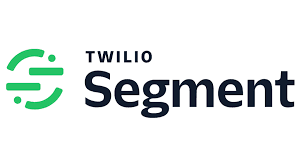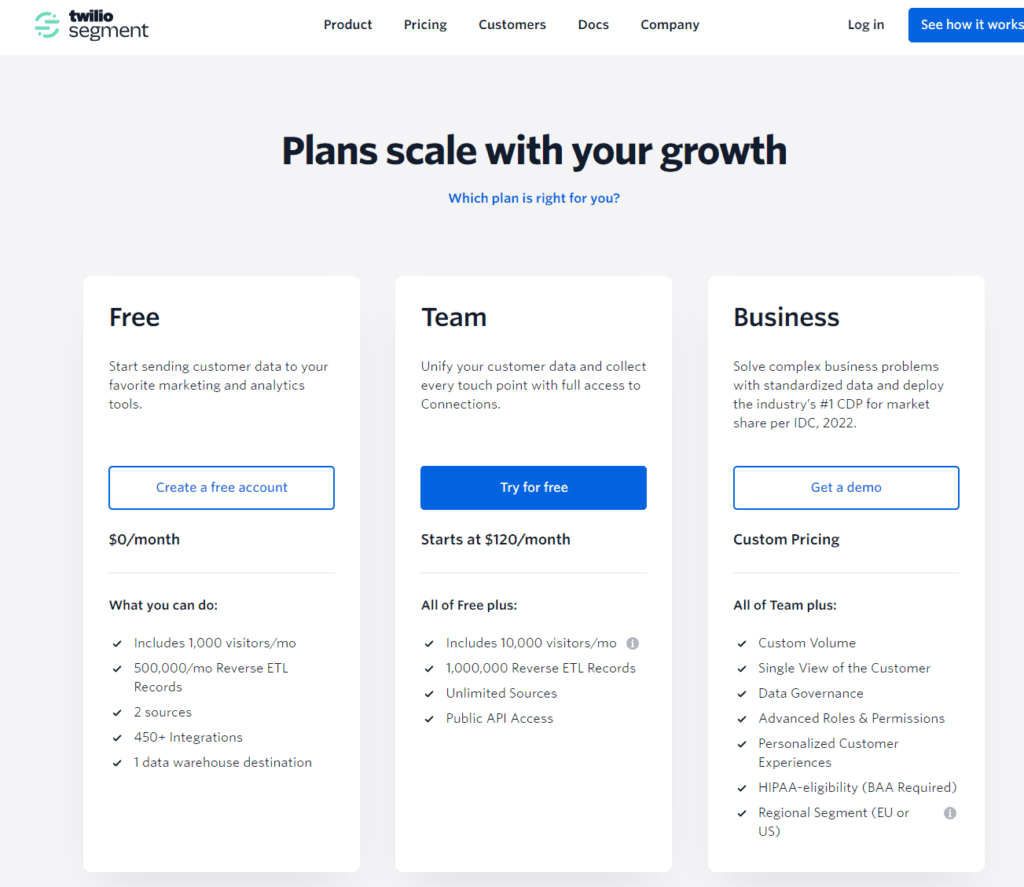In the bustling world of digital analytics, where data is the compass that guides strategic decisions, choosing the right tool can illuminate the path to success. Enter Crazy Egg and Segment, two beacons in the analytics landscape, each offering unique insights to navigate the digital expanse. But as their signals beckon, the choice between them is not merely a matter of direction but of destination.
Crazy Egg | Segment |
|---|---|
| G2 Score – 4.2 out of 5 stars | G2 Score – 4.6 out of 5 stars |
| TrustRadius Score – 7.6/10 | TrustRadius Score – 8.3/10 |
Integration Capabilities
In the digital ecosystem, where platforms and tools intersect across the vastness of the internet, the ability of an analytics tool to seamlessly integrate with other technologies is pivotal. It’s here, in the realm of integration, that Crazy Egg and Segment reveal their distinct paths.
Crazy Egg:
Crazy Egg provides a focused approach to analytics, primarily through heatmaps, scroll maps, and user session recordings. It’s designed to offer immediate, visual insights into how users interact with your website, making it invaluable for optimizing user experience and conversion rates. Integration with Crazy Egg is straightforward, requiring the insertion of a snippet of JavaScript code into your site. While it offers direct integrations with popular website platforms like WordPress, Wix, and Shopify, Crazy Egg’s integration capabilities are primarily centered around its core functionality of website analysis. This makes it an excellent tool for businesses and website owners who seek to enhance their site’s performance without the necessity for extensive cross-platform data aggregation.
Segment:
Segment, on the other hand, positions itself as a data hub, focusing on the collection, standardization, and routing of data across a multitude of analytics, marketing, and data warehousing tools. Its strength lies in its vast integration ecosystem, allowing businesses to consolidate data from various touchpoints into a single view. This unified data stream can then be seamlessly sent to hundreds of downstream tools for analysis, marketing automation, customer support, and more. Segment’s approach is inherently designed for scalability and flexibility, catering to businesses that operate with a complex stack of digital tools and require a comprehensive overview of customer interactions across all platforms.
User Experience and Ease of Use
This area is crucial for ensuring that the analytics tool you choose not only fits with your technical capabilities but also aligns with your team’s workflow, enabling you to quickly derive actionable insights without a steep learning curve. In the realm of digital analytics, the complexity of a tool can often be a double-edged sword. On one hand, more features and data points can provide deeper insights; on the other, they can make the tool less accessible to those without specialized training. Here’s how Crazy Egg and Segment compare in terms of user experience and ease of use.
Crazy Egg:
Crazy Egg has always prioritized a straightforward, intuitive user interface. Its dashboard and reporting systems are designed with clarity in mind, ensuring that users can easily navigate through various analytics features like heatmaps, scroll maps, and session recordings. This focus on simplicity makes Crazy Egg particularly appealing to small and medium-sized businesses, marketers, and website owners who need direct insights into website performance but may not have extensive technical expertise. The ease of setting up Crazy Egg, with just a snippet of code needed on your site, further enhances its user-friendliness, allowing users to start collecting valuable data with minimal setup time.
Segment:
Segment, while offering a powerful platform for data integration and analytics, presents a more complex user interface due to the nature of its functionality. The platform is designed to collect, unify, and connect customer data across every touchpoint, which inherently involves a more sophisticated setup process. Segment’s dashboard and toolset offer robust capabilities for those who are familiar with data analytics and integration strategies, but it may require a learning period for new users to fully leverage its potential. However, for teams with the necessary technical background, Segment provides unparalleled flexibility in managing and directing data flows across an entire tech stack, making it a potent tool for businesses aiming to create a comprehensive data ecosystem.

Related: Check out our free SEO suite

Customer Support and Community Resources
It is a critical factor that can significantly influence user satisfaction and the overall effectiveness of leveraging an analytics tool. The availability of support and resources not only aids in resolving technical issues but also enhances learning and maximizes the tool’s utility. The level of customer support and the richness of community resources are indicative of how well a platform can cater to its users’ needs, from onboarding to advanced troubleshooting and optimization strategies.
Crazy Egg:
Crazy Egg offers a range of support options designed to assist users at various stages of their analytics journey. This includes an online knowledge base filled with articles, guides, and tutorials that cover everything from getting started with Crazy Egg to interpreting complex heatmap data. For direct assistance, Crazy Egg provides email support, ensuring users can reach out with specific queries or issues. Additionally, Crazy Egg has nurtured a community of users who share insights and strategies across forums and social media, although it may not be as extensive or active as larger platforms. The value here lies in the accessibility of information and the focus on enabling users to quickly leverage the tool’s capabilities for website optimization.
Segment:
Segment, catering to a more technically diverse audience due to the nature of its product, emphasizes comprehensive support and a robust community ecosystem. Segment offers detailed documentation that not only guides users through the integration and data management processes but also provides best practices for data architecture. For immediate support needs, Segment includes email and live chat options, with the level of support varying based on the subscription tier.
Beyond direct support, Segment boasts a vibrant community of developers and data analysts, facilitated through forums, dedicated community events, and extensive third-party resources. This community serves as a rich resource for troubleshooting, advanced use cases, and custom integrations, reflecting Segment’s role as a foundational element in many businesses’ data strategies.
Implementation and Onboarding Process
This phase is pivotal for ensuring a smooth transition to using an analytics tool, impacting how quickly a team can start leveraging data insights to inform decisions and strategies. The ease with which you can implement and onboard an analytics tool into your existing workflows directly affects its adoption rate and overall utility. Here’s how Crazy Egg and Segment approach these initial steps:
Crazy Egg:
Crazy Egg is designed with simplicity in mind, not only in its use but also in its setup process. Implementing Crazy Egg typically involves adding a small snippet of JavaScript code to your website. This simplicity ensures that even users with minimal technical expertise can get Crazy Egg up and running quickly, allowing businesses to start collecting user interaction data almost immediately. The platform’s onboarding process is straightforward, with intuitive guides and prompts that help new users understand how to create and interpret heatmaps, scroll maps, and other visual analytics tools. This focus on ease of use extends to Crazy Egg’s educational resources, designed to help users quickly grasp the basics of website analytics and optimization.
Segment:
Segment, in contrast, caters to a more complex set of needs, acting as a data hub that collects, unifies, and routes data across many tools and platforms. Given its role as an infrastructure-level solution, Segment’s implementation can be more involved, requiring a thoughtful setup to ensure data is being collected and managed correctly. However, Segment provides extensive documentation, including best practices for data structuring and management, to guide users through this process. The onboarding experience for Segment is designed to equip users with the knowledge needed to build a robust data foundation, supported by resources for advanced data strategies and integration techniques. This comprehensive approach ensures that businesses can maximize the value of their data across the entire organization.
Data Privacy and Compliance
With regulations like GDPR in Europe and CCPA in California setting the stage for how businesses must handle user data, choosing an analytics tool that aligns with these requirements is not just about ethics; it’s a legal imperative. Both Crazy Egg and Segment operate in the global market, which means they must adhere to a variety of data protection laws and regulations. However, the nature of their services and the ways they handle data put different demands on their compliance strategies.
Crazy Egg:
Crazy Egg focuses on providing website analytics through visual tools like heatmaps and session recordings. Concerning data privacy and compliance, Crazy Egg has implemented features to help website owners comply with regulations. This includes options to anonymize user data and disable tracking for visitors who do not give their consent. Crazy Egg’s approach is to offer tools that make it easier for users to adhere to privacy laws, emphasizing transparency and control over data collection practices. While these features are beneficial, the onus is still on the users to ensure their specific implementations of Crazy Egg are compliant with the relevant laws.
Segment:
Segment, as a data integration platform, deals with a broader scope of data collection and management, acting as a conduit through which data flows between various tools and systems. Segment’s commitment to data privacy and compliance is evident in its robust set of features designed to manage consent across platforms, enforce data minimization, and ensure data is handled securely throughout its lifecycle. Given the complexity of Segment’s service, the platform has built-in mechanisms to help businesses automate compliance with various regulations, significantly reducing the compliance burden on users. Segment’s focus on data privacy is not just about providing tools but ensuring that the data ecosystem it enables is inherently designed to respect user privacy and comply with laws.
Pricing
Crazy Egg:

Segment:

Conclusion
Wrapping up our comprehensive comparison between Crazy Egg and Segment, we’ve journeyed through several key aspects that are crucial in deciding the best analytics tool for your business. From integration capabilities and user experience to pricing, customer support, and importantly, data privacy and compliance, both tools present distinct a dvantages tailored to different needs and operational contexts.
Crazy Egg stands out as a user-friendly option focused on enhancing website optimization through intuitive visual analytics. It’s ideal for businesses and website owners looking to quickly understand and improve user interactions on their site without delving into the complexities of broader data integration. Crazy Egg’s straightforward approach, coupled with its compliance features, makes it accessible for teams of all sizes, ensuring that valuable insights can be gained and acted upon with ease.
Segment, on the other hand, offers a robust solution for businesses looking to unify and leverage their data across multiple platforms and tools. Its comprehensive approach to data integration, combined with powerful compliance capabilities, positions Segment as a versatile platform for companies navigating the intricate landscape of data privacy laws. For organizations that prioritize a centralized data strategy and require a tool that seamlessly integrates with a vast ecosystem of apps and services, Segment provides the scalability and flexibility needed to harness the full potential of their data.
Read Next:
- GetResponse vs eSputnik: The Best Email Marketing Tool for 2024
- AWeber vs MoonMail: The Best Email Marketing Tool for 2024
- AWeber vs Aritic Mail: The Best Email Marketing Tool
- GetResponse vs Delivra: The Best Email Marketing Tool for 2024
- Constant Contact vs EmailOctopus: Best Email Marketing Tool






















Comments are closed.